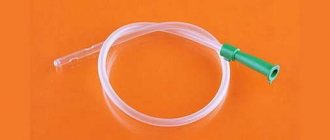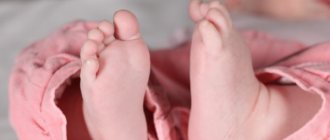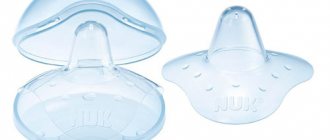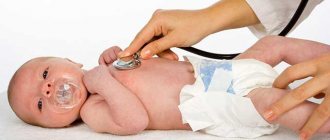Urinal: what is it and why is it needed?
This is a special polyethylene elastic container, the use of which helps to collect urine from a newborn. This is a sterile, pleasant to the touch and quite convenient device that greatly simplifies urine collection:
- Mom doesn't have to wait and catch the moment when the baby pees.
- Correct use of such a urine collection ultimately guarantees a reliable result, due to the fact that the urine goes directly into a sterile container.
- This device has a low price and is available to everyone.
- It is convenient and easy to use.
Features and use of urinals
Today there are many types of urinals, relevant in different situations. Such situations include:
- Urinary incontinence (uncontrolled urination);
- Postoperative period;
- Inability to move independently;
- Long-term catheterization;
- Removal of the bladder and subsequent ureterocutaneostomy;
- Acute cystitis accompanied by urinary incontinence;
- Other diseases of the genitourinary system;
In the question of how to use a urine bag, the main role is played by what device you use. They may differ in a number of ways. First of all, there are disposable and reusable urinals. Devices for single use are not intended for sterilization and are disposed of immediately after use. They also have a design that makes reuse impractical.
A regular reusable urinal is made from a material that can be sterilized, usually metal, glass, or plastic. Most often, these devices are bedside and are used in hospitals.
There are urinals with repeated intake of urine from one patient and subsequent removal; they are called individual reusable ones. They are usually made of latex and other polymers.
You can select devices:
- Drained - have a drainage hole for emptying;
- Undrainable - must be disconnected from the catheter each time it becomes full.
Male and female urinals are basically the same. Differences associated with anatomical and physiological characteristics have only catheters that are in direct contact with the patient’s urinary tract.
Separately, children's devices can be distinguished. Most often they are used when the doctor has prescribed a urine test for the baby. Bags for collecting urine in newborns are universal and can be purchased at any pharmacy.
Children's urinal in the NOVAMED catalog
Buy
Design and characteristics
- By design, it is a plastic bag that can hold a certain amount of liquid inside. There is a marking on the bag itself, the maximum mark is 100 ml.
- It has a hole for the genitals, which can be universal (has an oval shape and is suitable for use by all children) or separately for boys (the hole is ovoid and pointed at the bottom), or for girls (there are small branches at the bottom and sides of the hole).
- There is a special strip around the perimeter of the hole that is glued to the newborn’s skin. When properly glued, urine enters the container, which is then easily removed from the skin, without causing any inconvenience or discomfort to the baby.
How to use a urine collector
- First, you need to prepare your newborn as described above and wash your hands with soap. Any analysis must be carried out in the utmost purity. Some even suggest that mothers use sterile gloves when putting the pouch on their newborn.
- Now open the package, take it out, straighten it and remove the protective layer from the Velcro that is attached to the child’s skin.
- For a girl it needs to be attached over the labia, and for a boy so that the genital organ and testicles completely fit into it. It is very important to glue this device correctly, otherwise the urine will simply leak out. It’s better to stock up on not one, but several collections. If you fail to put it on correctly the first time, you will have the opportunity to use a new container and carry out the collection correctly. Indeed, the main difficulty that almost all parents encounter when using a urine bag for the first time is the ability to correctly attach the bag. And in most cases, the first gluing is unsuccessful, so it’s worth stocking up on such devices.
- After you put on the device, it is advisable to swaddle the baby or put on, for example, panties or a diaper, so that nothing moves. The child is constantly on the move and can easily remove the Velcro.
- As soon as the baby pees, the container needs to be peeled off, the place where it was glued should be rinsed with clean water, wiped with a towel and lubricated with baby cream. It is advisable not to leave glue residue on the skin so that the baby does not develop allergies.
- Make a cut at the bottom of the bag and pour the contents into a sterile container. It is necessary to pour it, because the laboratory will not accept the material for analysis if it is in this form.
If the material cannot be collected within an hour, further use of the urine bag is unacceptable, so it must be removed and a new one attached, otherwise the analysis results may be unreliable.
Urinal: what is it and what is it for?
Probably, the name alone has already prompted you to think about what a urinal is. This is a convenient and incredibly simple device for collecting urine .
It consists of a sterile polyethylene container, similar to a bag, with markings and a hole. Adhesive tape is applied to the edges of the latter, thanks to which the urinal is kept in the right place.
At the same time, the baby does not feel the slightest discomfort, but his mother experiences a feeling of deepest satisfaction, anticipating a quick outcome of the work begun. By the way, you can carefully examine this device and personally verify its benefits thanks to the photo.
I would like to note right away that urinals purchased in pharmacies are absolutely safe for the baby. Their glue contains nothing that could cause irritation or an allergic reaction, and it is easily washed off with warm water.
On the modern market there are both urinals for girls and boys, taking into account their physiological characteristics, and universal options.
It won’t be difficult to understand them, especially since they differ only in attachments :
- Oval ones are considered universal and equally effective for both boys and girls.
- The egg-shaped nozzles, somewhat pointed on one side, are intended for babies.
- Nozzles with branches on the sides are for babies.
A pleasant bonus when using a children's urinal is its price. With a pure heart, you can call it “penny” and, without hesitation, buy not one, but two urinals at once. In case you can’t glue it in the right place the first time.
Types of urinals
For patients in different clinical conditions, different types of urinals are provided. Depending on whether the patient can move or not, a bedside or wearable (foot) version is used.
Bedside urinals are used both in medical institutions and at home. They are used for bedridden patients who, due to health conditions, are not able to walk to the toilet on their own, as well as at night for patients with urinary incontinence. The device is fixed on the bed and structurally consists of an adapter, a bag for collecting liquid, a valve and an outlet tube. It’s easy to figure out how to collect urine in such a urine bag. There is a scale on the bag that shows how full the device is.
Foot wearable urine receivers. Used for patients with urinary incontinence who can move independently. A urine collection bag, as a rule, has a smaller volume than a bedside bag. Modern devices are convenient, can be invisible under clothing and create almost no discomfort when walking. You can either glue the urinal bag with Velcro or attach it using special fasteners with an elastic band to the lower limb. The devices allow the patient to feel comfortable and have a special non-return valve that prevents leakage even when the bag is tilted 180 degrees. The tube is soft and at the same time resistant to kinks.
Urinals in the NOVAMED catalog
Buy
Urinal: instructions for use
Sounds impressive, doesn't it? In fact, it is not at all difficult to use. The main thing is to follow certain rules so as not to cause inconvenience to yourself or the baby.
- Personal hygiene . Before you figure out how to use a urine bag, you need to thoroughly wash your baby. It is extremely important to remove any remaining powders and creams that may cause unreliable test results. Then you need to wash your hands with soap, after which you can proceed directly to the procedures. It is undesirable to neglect this stage. It allows you to maintain sterility - the key to the most accurate results of clinical studies.
- Removing the urine bag. Everything is simple here: open the package, take out a plastic bag and straighten it out.
- Removing the protective film . Most often this is wax paper, which is glued on top of a sticky layer, along the hole. You just need to remove it.
- Securing the urine bag . Due to the fact that this stage is the most critical, it must be carried out as calmly as possible. And for boys, this procedure is not particularly difficult, since the penis and scrotum are simply inserted into the hole, and it itself is secured along them with Velcro. For girls, everything is much more complicated. They have Velcro glued to the labia. And everything would be fine, only babies, like toddlers, can twitch their legs, squeal, and sometimes try to snatch and throw away the treasured bag. Don't forget this. By the way, this is why, at first, experienced mothers advise buying 2 urinals at once.
- Waiting for the result . To make it come faster, you can give the baby a little water or breast milk. And in order for the urinal to remain in its place, it is advisable to carefully put diapers or panties on the baby.
- Preparing for the analysis . After filling the urine bag, it’s time to remove it, cut a corner and pour the contents into a sterile jar, which, by the way, can also be purchased at the pharmacy.
- Personal hygiene . After completing all the procedures, you need to wash the child again to remove any remaining Velcro from his skin.
Important! If after an hour it was not possible to collect urine, you need to replace the urine bag in order to comply with the main condition - sterility.
After we have figured out what a urinal looks like and how it is used, it’s time to summarize. As for me, this is an excellent device that greatly simplifies life, especially if you have to take urine tests regularly.
Be sure to tell your friends about it by sharing our article. And don't forget to subscribe to our updates! There is still a lot of interesting things ahead!
And here you can watch a video instruction on using a urinal:
With that, I wish you good luck and say: “See you soon,” which will be my guest again, on the pages of this blog!
It's good when children are healthy. There is no greater joy for parents, but it happens that the baby gets sick, and this is not always an acute respiratory infection or dysbacteriosis. To clarify the situation, the doctor sends the child for diagnostics - ultrasound, tomography, tests. Most often, babies have to undergo a urine test, because even in the mother’s stomach, during examination, many children are diagnosed with underdeveloped kidneys, which can go away after a few months or persist as a pathology.
The rules for collecting urine in adults are known to everyone. For a couple of days you need to eat exclusively healthy foods, avoid sweets, flour, fried and fatty foods, do not smoke or drink alcoholic beverages. For the accuracy of the analysis, it is necessary to collect the morning average portion, and before the process it is better to wash thoroughly so that pathogenic flora from the outside does not blur the picture.
How to take children's urine for analysis?
The modern pharmaceutical industry has invented a device for collecting urine from babies, which was still unknown to our parents, so the process has become somewhat easier compared to Soviet methods. So, you can choose from the following range:
- urinal;
- plastic container;
- plastic bag.
Let us consider in detail the advantages and disadvantages of urine collection using each of the devices. After a detailed description of the procedures, you will be able to determine which one is most suitable for you and your baby, taking into account his characteristics, regime and temperament.
A pediatric urinal allows you to effortlessly collect urine from an infant
How to collect urine from a baby - video
The video below will help you more clearly understand the process of collecting urine from newborns. With its help, you will form an understanding of how to put on (glue) a urinal bag on a girl or boy. After reviewing it, you will eliminate possible errors in actions.
Modern knowledge and methods of child care make life much easier for young parents. Find out how to properly treat a newborn's navel. Taking advantage of such privileges, you periodically wonder how our grandmothers and mothers lived without being able to easily obtain the necessary knowledge.
We really hope that the information provided helped you choose the most convenient method for you. We will be grateful if you share your experience in the comments, it will definitely help someone.
Collecting urine using a urine bag
Children's urinals can theoretically be used by both boys and girls; they are produced with slight differences based on gender (we recommend reading: how to use a urinal for girls?). The difference lies in the location of the adhesive plate on the tank. They are made of polyethylene, and a division scale with milliliters is applied to the container bag. Along the edges of the hole, manufacturers apply glue of a hypoallergenic composition, with the help of which the product is attached to the skin.
Preparation
Have you decided to collect urine into a container using a urine bag? Purchase a special polyethylene urine collector and container into which you will then need to pour the biomaterial before submitting the material for examination. According to statistics, not many parents are able to successfully carry out this process the first time and correctly attach the urine bag to the child’s skin so that the biomaterial does not spill past, but ends up where it is needed.
Therefore, buy several urinals at once. Please note that it functions for an hour - it is not a fact that during this time the baby will want to pee, so you will have to attach a new product. According to the instructions, the product needs to be changed after 60 minutes of being on the baby’s body.
How to collect urine from a girl or boy using a urinal?
The sequence of your actions:
- Clean up your baby. Cleanliness of the genitals is the main rule of a clean analysis picture. Don’t forget that little princesses are washed from front to back, from the genitals to the butt (we recommend reading: how to properly wash a baby boy?).
- Wash your hands. Not only the baby’s genitals should be clean, but also everything that you will manipulate.
- Remove the urine bag from the packaging. Do not do this in advance to avoid compromising sterility.
- Remove the protective film from the adhesive strip.
- Spread the baby's legs and install the urinal so that the opening of the urethra is directly opposite the opening of the urinal.
- Pay attention to the notch that should be opposite the anus. It is not surrounded by a ring and allows you to avoid feces getting into the urine bag when defecating simultaneously with urination. Often babies go to the toilet both this way and that way.
- Are you taking a test from the boy? The penis and scrotum should be located inside the bag. Press the adhesive plate to the skin of the perineum, to the head of the penis. Place the product towards the tummy, upward.
- Are you taking a test from a girl? The bag should contain the labia majora.
- Put panties or a diaper over the urine bag so that the product does not come off the baby. Hold him in your arms, distract him from the object that irritates him until the child pees.
- When the product is full, carefully peel the bag from the baby's skin. Pour the urine into a container to take to the laboratory.
- Wash your baby again to remove any remaining glue.
Advantages and disadvantages of a urinal bag
The urinal was invented relatively recently. It greatly simplifies the diagnostic process. Modern mothers are deprived of the problems that our parents faced. The only drawback is the need for both parents and the baby to adapt to the process itself. Parents may not stick the device correctly the first time and the biomaterial may spill out. Children are usually bothered by the product, which is logical, and the baby may want to get rid of the foreign object on their skin as quickly as possible. Over time, everyone will get used to the process, the main thing is that the parents are calm and distract the baby. There are a lot of advantages. Urinals are sterile, durable, cheap and sold in almost every pharmacy.
Features of urine collection in a girl
Collecting urine from a girl is more difficult than from a boy. Before starting to collect the analysis, the child must be washed in the direction from the genitals to the butt , this will not allow bacteria to be introduced into the vagina. When washing, you need to be very careful, as the noise of the water can create urination. After washing the baby, wipe it dry with a towel or napkin.
Classic and modern method of collecting urine from girls:
- Classical. For this method, you will need a small deep saucer sterilized with boiling water, which is placed under the baby’s bottom. To speed up the process, you can stroke the baby's tummy clockwise. After collecting the analysis in a plate, it is poured into a jar, and the child is washed again, since with this method urine gets on delicate skin and can cause irritation.
- Modern. This method uses a urinal. When using this method, the child is washed and then laid horizontally. The urine bag is glued between the legs on the girl’s labia using an adhesive layer, and the child is placed in an upright position.
How to take urine using a bag?
This method was also used by our mothers. This is a homemade version of a urinal. The principle of operation is the same, but the system is quite inconvenient. A clean small plastic bag with handles is cut so that the handles can be secured to the baby's thighs. An improvised urinal is located between the baby's legs, and the baby must be held upright until he pees. If the child is very small and cannot be kept in an upright position for a long time, simply place the bag under the child. Don't forget about oilcloth so as not to stain the mattress.
How to collect biomaterial in a jar?
The most popular method of past decades. Now they also use it if the child has already reached one year of age. It is much easier to collect urine directly into a clean jar in a year than in a month. By jar we mean both the container directly for collecting biomaterial, which can be bought at the pharmacy, and small jars for baby food, mayonnaise, sour cream and others. Special containers are sterile, and food jars must be thoroughly washed and sterilized, at least doused with boiling water before use.
How to take urine into a jar:
- prepare the container;
- wash the baby and wash your hands;
- put the baby on the oilcloth and wait until he starts writing;
- take the middle portion, it shows the clearest diagnostic picture.
It is good to use a jar for boys, but for girls they often take a clean deep plate. Due to their physiological characteristics, it is easier to catch their urine in a wider container. The biomaterial should be carefully poured from a jar or plate into a special container.
On the container for analysis you need to write the name of the small patient, the date and time of urine collection
Current issues
The process of collecting urine from an infant and a newborn is difficult not only for the reason that it is difficult to collect biomaterial from a restless, unintelligent child. Before taking the test, parents may have the following questions:
- Why can’t you collect biomaterial from a diaper? Biomaterial obtained by twisting from diapers will be unclean. The villi and gel-forming elements contained in the middle layer of the diaper transform the composition of the biological fluid. In addition, in liquid form you collect very little biomaterial.
- How much should be sent for analysis? Qualitative analysis can be done with a minimum of biomaterial equal to 20 ml. The main thing is that the biomaterial be extracted from one portion. Urine from several portions is given in separate containers and sent for a special analysis - according to Nechiporenko (we recommend reading: how to collect urine according to Nechiporenko from a child?).
- What to do if you couldn’t collect the middle portion? This is not important. The cleanest portion is of course average, but when it comes to infants, the main thing is to generally collect the biomaterial from a clean baby into a sterile container after waking up.
What it is
A urinal is a special device in the form of a bag with a hole for collecting urine. It can be connected to a condom or a catheter. Used to empty the bladder in patients who do not control urination, in bedridden and postoperative patients. In some cases, this device is used to collect urine for analysis.
Kinds
Various criteria are used to classify special devices. Products can be reusable and disposable, intended separately for men and women, bedside, portable (foot-wear) or children's.
Also classified as drained or undrained. According to their structure, these devices are divided into one-component, two- or three-component.
Disposable devices can only be used once, as the material from which they are made cannot be sterilized or otherwise processed. Disposable devices include devices whose structure does not allow them to be reused, for example, devices with valves.
To produce reusable devices, special materials are used that can withstand repeated sterilization processes. These include latex, plastic, glass or metal products. Often these devices are used in hospital settings. Once sterilized, they can be used repeatedly, even to collect urine from different patients. Latex and polymer devices are designed for repeated use as individual devices. They must also be processed and sterilized.
By design they are distinguished:
- The one-component urinal has the shape of a bag with an adhesive plate - it reliably fixes the device to the skin.
- The two-component device is also made in the form of a bag, but it is a removable device and can be attached to a condom or catheter.
- The three-component device has a more complex structure. The bag contains a drainage tube and an anti-reflux valve that closes the hole for collecting urine.
Women's and men's
The shape of male devices is determined by the characteristics and anatomical shape of the male reproductive system. This can be a urinal equipped with an elongated neck, or disposable urocondom systems that are securely fixed to the male organ.
Women's devices have a completely different shape, with maximum adherence to the skin. For reusable use, use a vessel with a wide opening, or a “duck” with a neck in the form of a narrow sheet. Disposable female systems have a wide ring and a valve that controls ureteral backflow.
Drained and undrained
Drainable devices are equipped with a special tube that allows you to remove the accumulated portion of urine from the receiving bag. This compares favorably with a undrained device, in which the bag must be disconnected from the catheter or urocondom each time to remove the contents.
According to the form of wearing
In hospital settings, bedside urine collection devices are used for bedridden and critically ill patients. The most common urinals: standard and improved luxury type.
Foot-mounted or wearable devices are used by patients who move not only within the hospital. They must meet several requirements. The main condition is to create minimal comfort and freedom for the patient when moving. Their shape should be such that the device is not very noticeable under clothing. Wearable devices are divided into regular and enhanced.
Regular or standard, improved models
They have a straight tap, the entire bag is made of one material, without lining. Polyvinyl chloride can cause irritation, especially with constant use. But conventional wearable devices have a low price, and this is their main advantage.
Improved types of devices are equipped with a T-shaped tap, which allows you to remove the contents from the drive without the risk of spilling it. The side of the receiver adjacent to the skin has a special soft lining that protects the skin from irritation. Almost all models in this class have special ties that secure the device to the leg. There are samples that are attached to the belt.
Children's devices
The main condition for children's models is to ensure comfortable use when collecting urine from the youngest. For young parents, it is often a problem to collect at least a minimum amount of urine for analysis. Today it has become possible to solve this issue, since there are devices even for infants. They help collect the right amount of urine without causing discomfort or stress to the baby.
Outwardly, it resembles a small bag with a small hole in it. With the help of soft Velcro, it can be easily fixed on the baby's skin. This is completely safe for the child and does not cause any inconvenience. It should be noted that even for the smallest children, you should select a device taking into account the gender of the baby, since models for boys differ from devices intended for girls.
Polyethylene is used to make bags for children's models. The bag is securely attached to the baby's skin using Velcro. All urine is collected in a bag that has special markings indicating the amount of material collected. Standard versions of baby devices can collect 100 milliliters of urine.
Velcro is a concern for many parents. They are afraid that this type of pouch fixation may cause discomfort, irritation and even pain. However, these experiences are in vain. The adhesive composition in the adhesive tape is completely safe for the baby’s skin; it can be easily removed at any time, while the baby’s skin will remain smooth, without redness or damage.
For children, urinals are divided into three types, in accordance with the anatomical features of different sexes:
- for boys;
- for girls;
- universal.
Universal urinals have oval holes, are suitable for babies of any gender and are the most comfortable of all other devices. Models intended for boys have the shape of an elongated egg, pointed downwards. Urine collectors for girls have a rounded shape with side branches.
Advantages and disadvantages
Urinal bags have recently become available to all segments of the population. These devices help facilitate the process of collecting urine for laboratory tests and disease diagnosis. The main advantages of urine collection devices:
- High level of sterility. If a child’s urine is first collected in a pot and then poured into a sterile container, then microorganisms will inevitably get into the material.
- Low cost, affordable for everyone.
- Reliability and practicality of the device. The high quality polyethylene from which children's models are made can easily take any shape, depending on the position of the child's body.
- The anti-return valve provided by the manufacturer prevents the reverse flow of urine and its leakage in places of the adhesive tape through small holes.
- Easily attaches to the body of even a sleeping baby.
There are almost no shortcomings in children's devices. On particularly sensitive skin, slight redness may occur at the site where the container is glued. If the device is used for the first time, then it is necessary to monitor the baby’s behavior while securing the container and removing it. If swelling or redness occurs on the child's skin after removing the device, you should consult your pediatrician about further use of the urine bag.
How to get your baby to pee as quickly as possible?
A pressing question that worries parents is how to speed up the process of urination of a newborn, especially if urine is collected not using a urine collector, but in a jar or deep plate. The younger your child is, the more often he goes to the toilet - for example, newborns pee up to 20 times a day. The baby's parents don't have to wait long to catch the urine. If we are talking about an older child, the waiting time may extend. What to do to make your baby pee faster:
- bring the baby to the water tap;
- turn on the water in the bathroom if the children's room is located close and the sound of the water can be clearly heard (this provokes urination);
Sometimes it’s enough just to turn on the water for a few minutes - the baby’s body will do the rest.
- lightly warm the baby’s lower abdomen with a warm diaper or with your hand;
- attach the baby to the breast if he is on breastfeeding, or give him a drink from a bottle;
- give a light massage below the navel;
- pour water from container to container next to the baby.
Collecting urine from infants in a container
A container is a pharmaceutical plastic jar with a tightly screwed lid, the inside is sterile and does not require treatment before collecting urine. It may not be sterile, but this is indicated on the packaging, so you need to read it carefully or ask the pharmacist. How to collect urine from a baby in another container? If improvised utensils, for example, a glass jar, are used as containers, then treatment with boiling water or steam is required.
The amount of fluid released is proportional to the volume that enters the baby’s body in the form of milk; it is 180-220 ml per day, it increases every day, and by the end of the first month of life it is 900-1000 ml. Accordingly, there should be no shortage.
In infants, urination occurs regularly, after a certain period of time. If you notice this cyclicality, you can easily adjust to the next bowel movement and take a sample for analysis.
How to collect urine from a newborn girl in a container? The jar is placed when the child has already begun to pee: the first drops washing the perineum may not contain pure material. The best urine is considered to be average relative to the urination process. On the other hand, this is also not important if we are not talking about the so-called “Nechiporenko” test.











